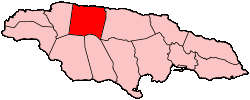
Population: 72,600
Capital: Falmouth
Major Towns: Clarks Town, Stewart Town, Duncans, Wakefield, Jackson Town, Ulster Spring, Wait-a-Bit, Albert Town

Trelawny is nestled in the northwestern part of Jamaica, spanning approximately 874.6 square kilometers (353 square miles). The parish features expansive plains such as Queen of Spain’s Valley and Windsor—elevated at 750 and 580 feet respectively—while much of the southern region maintains a uniform elevation of 750 feet.
The southern part is an integral component of the Cockpit Country, a rugged, pristine reserve that shelters nearly all of Jamaica’s 27 endemic bird species, a non-venomous yellow snake, and the giant swallowtail butterfly—the largest of its kind in the Western Hemisphere. Mount Ayr, the highest point in Trelawny, towers at 3,000 feet above sea level.
Established in 1770, Trelawny was formed by carving it out of eastern St. James and western St. Ann to better serve its remote communities. Named after Sir William Trelawny, then Governor of Jamaica, its first capital was Martha Brae, situated two miles inland from Rock Bay. With the highest concentration of sugar estates in Jamaica, the pressing need for an efficient seaport led to the acquisition of lands from Edward Moulton Barrett. Barrett Town, later renamed Falmouth, quickly evolved into one of Jamaica's most well-planned towns—a bustling seaport and social center characterized by elegant townhouses and vibrant local media, including The Falmouth Post and The Falmouth Gazette.
Falmouth's illustrious past includes hosting Jamaica’s inaugural Derby at Cave Island and playing a pivotal role in the emancipation movement under the leadership of Rev. William Knibb. Today, Falmouth stands as an architectural and historical treasure that urgently needs preservation.
The Maroons, descendants of freed and runaway slaves, once established their chief town in the Cockpit Country of southern Trelawny. A 1739 treaty with the English secured their freedom and land, curtailing their raids on sugar plantations; however, a subsequent uprising in 1795 resulted in the exile of over 600 Maroons—first to Nova Scotia and later to Sierra Leone—leading to the destruction of Trelawny Town.
Today, Trelawny continues to be an agricultural powerhouse with significant potential for eco-tourism and historical preservation.
Agriculture: The parish produces sugar cane, yams, strawberries, various vegetables, pimento, coffee, ginger, coconuts, and dyewoods.
Tourism: With growing investments in eco-tourism, major hotels like Braco Village Resort, Silver Sands Resort, and Trelawny Beach Hotel are enhancing the local economy.
Trelawny is home to 25 factories that manufacture sugar, rum, apparel, and more. The Hampden Sugar Factory and Trelawny Sugar (formerly Long Pond Sugar Factory) serve as key industrial employers, complemented by a thriving fishing sector.
Falmouth Court House: Constructed in 1815 and rebuilt after a 1926 fire, this stately building boasts an elegant portico supported by four Doric columns and a grand double staircase.
Falmouth Parish Church: The Anglican Church of St. Peter's, built in 1795 on land donated by Edward Barrett and expanded in 1842, is the oldest church in the parish.
Hyde Hall Estate: This historic estate features a monument dedicated to a slave named Eve, highlighting its deep-rooted ties to the region’s past.
Windsor Caves: Offering guided tours through impressive galleries of stalactites and arched ceilings, these caves reveal the underground roar of the Martha Brae River during the rainy season.
Oyster Bay (Luminous Lagoon): Renowned for its bioluminescent micro-organisms that create a mesmerizing glow at night, this natural wonder transforms the bay into a celestial spectacle.
Good Hope Great House: Dating back to 1742 and once owned by one of Jamaica's wealthiest men, John Tharp, this Georgian-style mansion has been beautifully restored as an elegant hotel.
The Dome: Constructed in 1801, this iron foundry was instrumental in repairing sugar estate machinery during Jamaica's sugar boom.
Martha Brae River Rafting: Experience a memorable 90-minute bamboo raft journey along the serene Martha Brae River, complete with inviting bathing pools and refreshing shady glades.
Trelawny's exceptional blend of historical depth, natural splendor, and dynamic economic potential ensures it remains a cornerstone of Jamaica's cultural and ecological landscape.